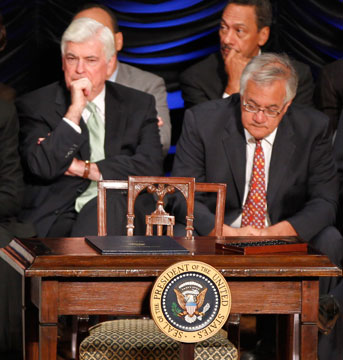Glass-Steagall
In the wake of the 1929 stock market crash, thousands of banks failed, public trust in the system collapsed and bank runs were common. One of the first acts of the New Deal, the Banking Act of 1933, known as the Glass-Steagall Act because it was introduced by former Treasury Secretary Sen. Carter Glass (D-VA) and Chairman of the House Banking and Currency Committee Rep. Henry B. Steagall (D-AL), sought to limit speculation and make banks safer repositories for public money. (See one of the few digital versions of the Glass-Steagall Act).
The law had two main provisions: It separated commercial banks from investment banks in order to protect people’s bank accounts from risky investments, and it created the Federal Deposit Insurance Corporation (FDIC), which insures bank deposits with “the full faith and credit of the United States Government.”
Today, the term “Glass-Steagall” generally refers to the provision separating commercial and investment banks. In 1999, after a decade of increasing financial industry deregulation, this “wall” was torn down by the Financial Services Modernization Act. The bill, also known as the Gramm-Leach Act, was passed by overwhelming majorities in both the House and Senate, and signed into law by an enthusiastic President Clinton. It paved the way for the creation of banking behemoths like Citigroup, Bank of America and J.P. Morgan Chase. A decade later, the repeal of Glass-Steagall was widely considered a major cause of the 2008 financial collapse.
Dodd-Frank

The financial crisis of 2008 was followed by the worst economic slump since the 1930s. In its wake, Congress passed the Dodd-Frank Wall Street Reform and Consumer Protection Act. The legislation intended to “promote thefinancial stability of the United States by improving accountability and transparency in the financial system, to end ‘too big to fail,’ to protect the American taxpayer by ending bailouts, to protect consumers from abusive financial services practices, and for other purposes,” according to the bill’s subtitle.
The act, signed by President Obama on July 21, 2010, is the most sweeping overhaul of the financial system since the Great Depression. It calls for up to 400 new regulations, many of which are still being written, and for a host of new regulatory and watchdog agencies, including the Financial Stability Oversight Council, the Office of Financial Research and the Bureau of Consumer Financial Protection.
The bill imposes new restrictions on derivatives and calls for public exchanges where these complex financial instruments would be traded, limits debit-card fees, and attempts to put an end to “too big to fail” by imposing new regulations on banks with more than $50 billion in assets and giving the government authority to liquidate them when they run into trouble.
Despite all these regulations, Dodd-Frank never goes as far as Glass-Steagall did in separating commercial and investment banking. The closest it gets is the so-called Volcker Rule, proposed by former Federal Reserve Chairman Paul Volcker, which bans banks from risky speculative trading with federally-insured money. The Volcker Rule was enacted as part of Dodd-Frank in 2010 and is scheduled to be implemented on July 21st, 2012, but the specifics are still being debated by legislators, regulators and bank lobbyists.
Explore More
Primary Sources
For all that’s been written about Glass-Steagall since the 2008 financial crisis, we couldn’t find the original document anywhere online. This PDF of the original Glass-Steagall Act is brought to you by our administrative assistant, Sean Ellis, who trudged down to the New York Public Library and photocopied it.
More recent bills (1989-present) are readily available on The Library of Congress Thomas website. Here’s the final version of the full Dodd-Frank Wall Street Reform and Consumer Protection Act. But before you press print on a document that’s been ridiculed for it’s excessive length, you might want to consider sticking to the cliffs notes.
Analysis
PBS’s Frontline chronicles the rise and fall of the Glass-Steagall Act.
Bill Moyers talks with Simon Johnson and Michael Perino about the Pecora Hearings, which helped create the furor that led to Glass-Steagall.
First impressions of the Dodd-Frank bill from The New York Times’ Dealbook blog.
Rolling Stones’ Matt Taibbi says that Congress looked serious about financial reform, until the banks unleashed an army of 2,000 paid lobbyists.
ProPublica explains how the rules called for in the original Dodd-Frank bill have been muddied and watered down.
New York Times columnist Joe Nocera wonders if the bankers might have a point about the new regulations being overly complex.
The Economist calls Dodd-Frank “Too big not to fail.”
WNYC compares Glass-Steagall with the Volcker Rule.
The New York Times’ Dealbook blog calls the Volcker Rule “good as dead.”

